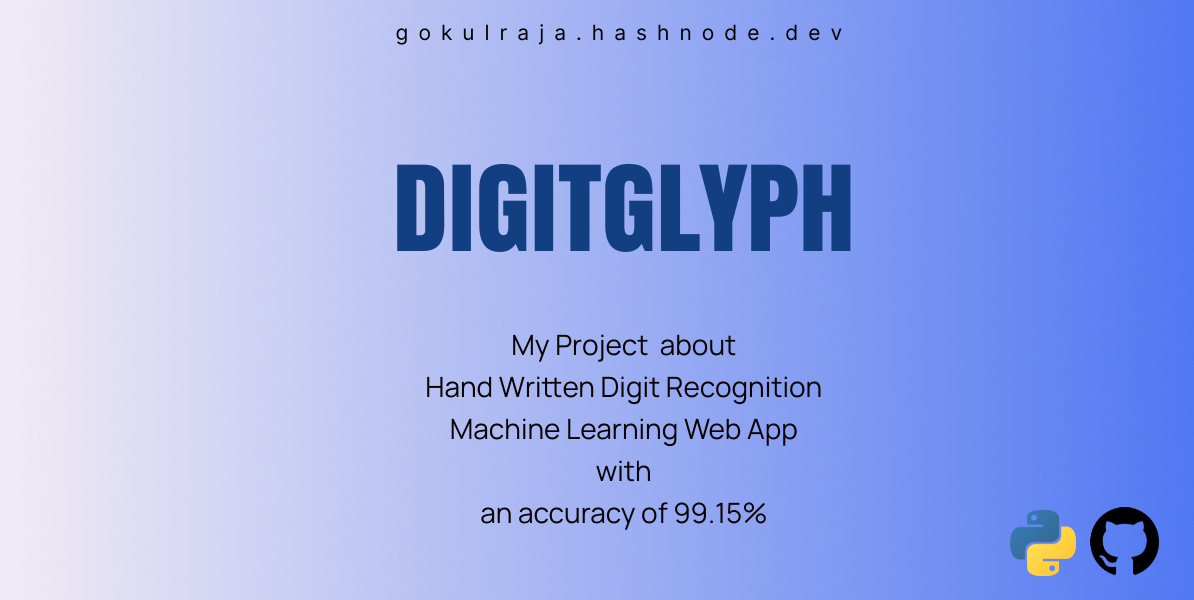DigitGlyph
 Gokul Raja
Gokul Raja
Unveiling DigitGlyph: My Journey to 99.15% Accuracy in Handwritten Digit Recognition
Introduction
Machine learning is revolutionizing every field, and one of its coolest applications is handwritten digit recognition. Today, I'm super excited to introduce DigitGlyph, a cutting-edge machine learning web app that uses Convolutional Neural Networks (CNNs) to achieve a jaw-dropping 99.15% accuracy in classifying handwritten digits. In this blog post, I'll take you on the thrilling journey of developing DigitGlyph, sharing the challenges, solutions, and amazing results we achieved along the way.
The Inspiration Behind DigitGlyph
DigitGlyph was inspired by the everyday need to accurately recognize and classify handwritten digits in countless real-world scenarios. Whether it's postal code recognition or automated form processing, being able to interpret handwritten digits accurately is crucial. I set out to create a solution that not only nails the accuracy but also provides a seamless user experience.
The Technology Stack
DigitGlyph is built on a solid, modern technology stack to ensure top-notch performance and accessibility:
Python: The backbone of our machine learning algorithms.
TensorFlow : For building and training our CNN model.
TensorFlow.js: To bring our ML model into the web app for real-time predictions.
JavaScript: For a smooth, interactive user interface.
GitHub Pages: Hosting the project for worldwide accessibility.
The Development Journey
Data Preprocessing
The first step was data preprocessing. We normalized the image data to ensure consistent input for our CNN model. Advanced data normalization techniques helped us significantly boost the model's performance.
Model Architecture
At the heart of DigitGlyph is its CNN model, meticulously designed to extract and learn features from input images. The model includes multiple convolutional layers, each followed by activation, pooling, and normalization layers to ensure optimal feature extraction and learning.
Overcoming Challenges
The journey wasn't without its bumps. A major challenge was optimizing the model's hyperparameters to hit our accuracy target. Through rigorous testing and fine-tuning, we added dropout layers to prevent overfitting and batch normalization to stabilize learning. The ReLU activation function handled non-linearity and sped up training, while the Adam optimizer efficiently updated the model's weights. Categorical cross-entropy was used as the loss function for our multi-class classification tasks. These tweaks pushed our model's accuracy to an incredible 99.15%!
Ensuring Model Generalization
To prevent overfitting, dropout layers randomly deactivated neurons during training, reducing reliance on specific features. Batch normalization helped stabilize learning by normalizing activations. We closely monitored training and validation loss for signs of overfitting and adjusted the dropout rate as needed.
Interactive User Interface
Making DigitGlyph user-friendly was key. Using JavaScript and TensorFlow.js, we created an interactive UI that lets users draw digits on the screen and see real-time predictions. This powerful backend and intuitive frontend combination ensures a seamless and engaging user experience.
Deployment and Accessibility
Hosting DigitGlyph on GitHub Pages made it accessible to anyone with an internet connection, showcasing the power of modern web technologies in deploying machine learning models.
Results and Impact
DigitGlyph's 99.15% accuracy speaks volumes! This project has not only honed my machine learning and web development skills but also serves as a valuable tool for anyone interested in handwritten digit recognition.
Conclusion
Developing DigitGlyph has been an exhilarating journey filled with challenges, learning, and triumphs. Its success underscores the power of modern machine learning techniques and the importance of perseverance and innovation. I invite you to explore DigitGlyph, play with the code, and contribute to its further development. Let's keep pushing the boundaries of what's possible with machine learning and technology.
Stay tuned for more updates, and connect with me on GitHub for feedback, suggestions, or collaborations. Together, let's dive deeper into the fascinating world of machine learning and its endless possibilities.
Live hosted link - https://gokul-raja84.github.io/DigitGlyph/
Project Github repo link - https://github.com/Gokul-Raja84/DigitGlyph
Subscribe to my newsletter
Read articles from Gokul Raja directly inside your inbox. Subscribe to the newsletter, and don't miss out.
Written by

Gokul Raja
Gokul Raja
Software dev looking for exciting opportunities. Here on Hashnode to blog my tech journey !